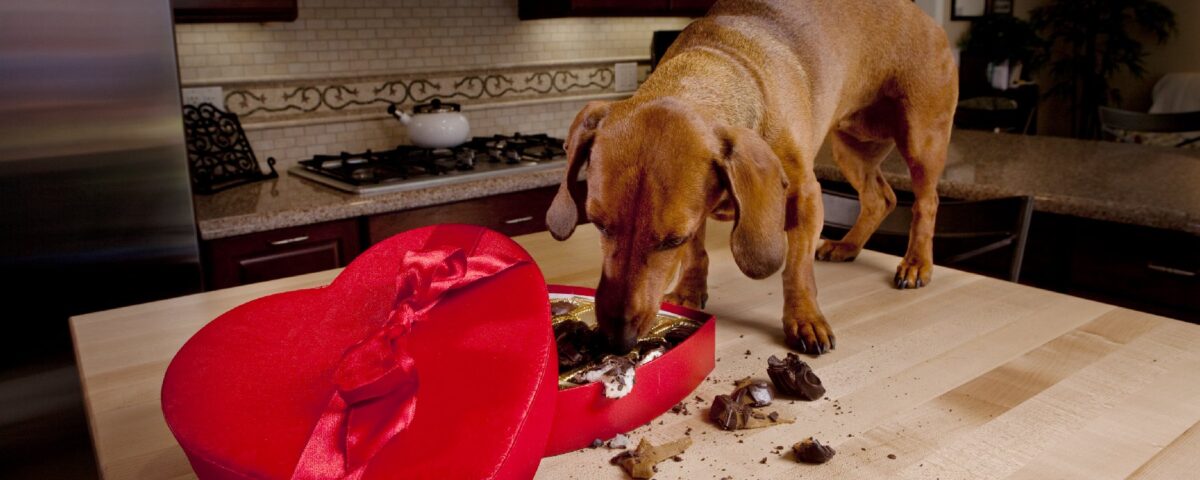
Why Can’t My Dog Eat Chocolate?
Posted: 06/23/2022 | Categories: Dog nutrition
Dogs that have eaten chocolate are regular emergencies for veterinarians everywhere, but what is it about the delicious candy that is so good to us, yet so dangerous for our best friends? The answer lies in the fact that a dog’s body can’t break down substances called mathylxantines like human bodies can, causing potential deadly symptoms.
Depending on the size of your dog and the type of chocolate they have eaten, the toxic substances will have varying effects, but it’s important to make a trip to the vet, to be safe.
Why is chocolate dangerous to dogs?
Chocolate contains varying amounts of substances called methylxanthines, most notably caffeine and theobromine. These substances act as stimulants in dogs, increasing the heart rate and putting pressure on the central nervous system and kidneys. Whilst human bodies can break down these substances quickly, a dog takes much longer, meaning the effect on them is far greater.
The stimulants’ effect on the body is dangerous because if the dose is too high it can lead to seizures, heart attacks and perhaps even organ failure. Even a smaller amount can have unpleasant effects on your dog causing vomiting and incontinence.
However, it’s not just these substances that cause chocolate to be dangerous to dogs. High levels of fat and sugar can also cause serious problems if consumed, even if it’s only on one occasion. Unexpected peaks in sugars and fats can cause your dog’s pancreas a great deal of stress, which in extreme cases, can lead to pancreas failure up to 3 days later.
What are the symptoms of chocolate poisoning?
The recognizable symptoms of chocolate poisoning in dogs can vary from pet to pet, but the main ones to look out for include:
- Vomiting
- Diarrhea
- Increased urination / incontinence
- Seizures
- Tremors / shaking
- Hyperventilating
- Increased heart rate
Not all dogs will display all or any symptoms when suffering from chocolate poisoning, so if you know that your dog has eaten chocolate it’s important to seek veterinary advice as soon as possible, even if there are no visible symptoms.
How much chocolate is dangerous for my dog?
The amount of chocolate that can be life threatening to a dog varies hugely depending on the type of chocolate and the size of your dog. Generally speaking, the more bitter the chocolate, the higher concentrate of toxic substances are present. This means that bakers chocolate and dark chocolate are the most dangerous for your dog gram for gram.
A large dog may be able to consume an ounce of milk chocolate without any problems whatsoever because his size dilutes the toxins, however for a small dog the same amount could be fatal.
White chocolate is the least toxic form of chocolate because of its low cacao levels. However, it still contains very high amounts of fat and sugar and so can be dangerous in other ways.
There are some useful online calculators available as a guide to how much chocolate is dangerous for your dog, but these should be used with caution as every dog is different. In any case where you know your dog has consumed chocolate, always contact a veterinarian for advice; it’s never worth the risk!
How is chocolate poisoning treated?
If you manage to bring your dog to your veterinarian within a couple hours of ingestion, they will safely induce vomiting to rid the stomach of any chocolate that is yet to be digested. They may also flush the stomach with decontaminating substances such as activated charcoal.
As ingesting chocolate is sadly such a common occurrence for pets, it’s advisable to ask your vet to teach you how to safely induce vomiting in your dog so that you can act quickly yourself if ingestion occurs again. They will be able to recommend products such as hydrogen peroxide, and will be able to tell to how much is a safe measure to induce vomiting in your dog.
If the situation is more serious, the next level of treatment would be for your dog to have an overnight stay at the veterinarian practice with constant fluids and anti-seizure medication. The veterinary nurses will try and counter the effect of the stimulating toxins on the heart and muscles to stabilize your dog until they have fully eliminated the toxins.
Is chocolate dangerous for cats too?
Chocolate is toxic for cats as well as dogs, in fact, it’s significantly more dangerous for cats to consume, and takes much less to cause a poisoning.
However, chocolate poisoning is much more prevalent in dogs because cats do not have sweet taste receptors like dogs do, so are more likely to turn their noses up at chocolate rather than scoffing it down.
Chocolate is also poisonous to rabbits, so bunnies kept in the house are also at risk of finding a potentially fatal snack. The mathylxantines are much less toxic to small rodents such as rats and mice.
Remember to keep any human sweet treats away from your pets this Valentine’s and Easter period, but that doesn’t mean you can’t spoil your pets too! There are lots of dog friendly chocolates available from pet stores which are made without mathylxantines, although these are still often high in sugar and fat so be sure to check the label for recommended serving sizes. Or alternatively, why not make your own healthy dog treats with dog-friendly ingredients.
Read about other human foods that are dangerous for dogs on our Toxic Foods for Dogs page